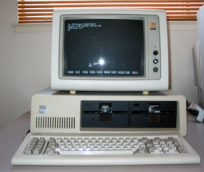Where Did BASIC Come From?
This post is part 6 (out of 6) in a series of blog posts:
- Computers Today
- Where Computers Came From
- Computer Hardware
- Computer Programs
- Why Are There so Many Programming Languages?
- Where Did BASIC Come From? (this blog post)
Now that we’ve discussed the different languages a little (see Why Are There so Many Programming Languages?), and before we get into the details of Small Basic, let’s take a quick look at the history of its grandparent, a language called BASIC.
BASIC stands for (hold on to your hat) Beginner’s All-Purpose Symbolic Instruction Code, and it’s a high-level programming language that was developed in 1964 (at Dartmouth College) to make programming easier. Because the language was very easy to learn, it was used widely. Computer manufacturers started to ship it with their machines. Figure 1 shows you a computer that’s running BASIC.
Figure 1: The original BASIC programming language
The manufacturers also extended the language by adding new keywords. This resulted in many incompatible dialects of the original BASIC language (a BASIC program written for one machine might not work on another).
In 1975, Micro Instrumentation and Telemetry Systems (MITS) released a BASIC interpreter for one of their microcomputers. The interpreter was a product of a small company called Micro-Soft (which eventually grew into today’s Microsoft) and was created by Bill Gates and Paul Allen (see Figure 2).
Figure 2: Bill Gates presenting Microsoft’s BASIC interpreter in 1975
This interpreter was the start of Microsoft’s BASIC products, like GW-BASIC and QuickBASIC. In the 1980s, more powerful programming languages were created, and BASIC started to lose its appeal. In the early 1990s, Microsoft revived the language by releasing Visual Basic (VB), which greatly simplified the development of graphical user interface (GUI – pronounced “gooey”) applications. VB eventually evolved into Visual Basic .NET. The term .NET refers to the new way of creating programs for Windows.
And then VB leads us to Small Basic! Small Basic wanted to capture the ease of learning how to program with BASIC, but to simplify it greatly, and to leverage the object-oriented power introduced via Visual Basic.
Go to https://blogs.msdn.com/SmallBasic to download Small Basic for free and learn all about it!
Next, read Parts 1-5 in this series if you skipped them:
- Computers Today
- Where Computers Came From
- Computer Hardware
- Computer Programs
- Why Are There so Many Programming Languages?
- Where Did BASIC Come From? (this blog post)
Have a Small and Basic day,
- Ninja Ed & Majed Marji

